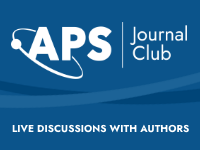| Volume 107, Issues 7 - 8 April 2023 | |
| Not an APS member? Join today to start connecting with a community of more than 50,000 physicists. | | | | Editors' Suggestion Jaakko Annala and Kari Rummukainen Phys. Rev. D 107, 073006 (2023) – Published 24 April 2023  | Using high precision numerical simulations, the authors investigate the electroweak sphaleron of the standard model in an external (hyper)magnetic field. They find that the electroweak crossover temperature decreases with increasing field strength and the sphaleron rate suppression is shifted to lower temperatures. | | | | | | Editors' Suggestion Antonio Condorelli, Denise Boncioli, Enrico Peretti, and Sergio Petrera Phys. Rev. D 107, 083009 (2023) – Published 5 April 2023  | The sources and acceleration mechanisms for observed ultra-high energy cosmic rays (UHECRs) are abiding problems still needing definitive resolution. The authors of the present study investigate the potential of starburst galaxies (SBGs) - so named for being particularly active environments for formation of new stars - to be the sources of UHECRs. Using Monte Carlo simulations of the extremely dense and turbulent environment in the most active region of SBGs, the authors show by a highly suggestive comparison to data obtained by the Pierre Auger Observatory that SBGs can be sources of UHECRs. | | | | | | Featured in Physics Editors' Suggestion Zidu Lin, Abhinav Rijal, Cecilia Lunardini, Manuel D. Morales, and Michele Zanolin Phys. Rev. D 107, 083017 (2023) – Published 11 April 2023  | Simultaneously detecting the gravitational-wave and neutrino signals emitted during the last second of a massive star's life could show how such stars die. | | | | | | Editors' Suggestion Mattia Di Mauro, Judit Pérez-Romero, Miguel A. Sánchez-Conde, and Nicolao Fornengo Phys. Rev. D 107, 083030 (2023) – Published 24 April 2023  | The authors analyze 12 years of Fermi-LAT data for 49 galaxy clusters to look for a γ-ray signal between 500 MeV and 1 TeV due to dark matter annihilation. Physically motivated dark mater density distribution templates and a thorough statistical approach lead to a low significance signal, unlikely to be due to dark matter processes. | | | | | | Editors' Suggestion T. M. C. Abbott et al. (DES Collaboration) Phys. Rev. D 107, 083504 (2023) – Published 5 April 2023  | The authors use Dark Energy Survey data on galaxy clustering and lensing from the first three years of observations combined with five prominent external datasets. They robustly constrain six potential extensions to the currently prevalent cosmological paradigm of ΛCDM (Cold Dark Matter with a cosmological constant). All extensions would add significant new physics, such as deviations from General Relativity or non-zero spatial curvature, but no significant evidence for new physics is found. | | | | | | Editors' Suggestion Pierre Heidmann, Ibrahima Bah, and Emanuele Berti Phys. Rev. D 107, 084042 (2023) – Published 25 April 2023  | The authors study photon geodesics in the gravitational background generated by smooth horizonless topological solitons with the same large distance behaviour as neutral non-rotating black holes. They show that incoming photons experience very high redshift, inducing phenomenological horizon-like behaviors from the point of view of photon scattering. Thus, they provide a compelling case for real-world gravitational solitons and topological alternatives to black holes. | | | | | | Editors' Suggestion Raphael Bousso and Geoff Penington Phys. Rev. D 107, 086002 (2023) – Published 4 April 2023  | As part of the AdS/CFT dictionary, the entanglement wedge reconstruction identifies the spacetime region in AdS that is dual to a given CFT subregion on the boundary. In this paper, the authors make an important step forward by extending the entanglement wedge reconstruction to arbitrary spacetimes, which can reveal aspects of the full quantum theory of gravity. | | | | | | Editors' Suggestion Markus Dierigl, Jonathan J. Heckman, Miguel Montero, and Ethan Torres Phys. Rev. D 107, 086015 (2023) – Published 26 April 2023  | The authors argue for the existence of a new object in string theory which they dub Reflection 7-Branes (R7-branes). The so-called cobordism conjecture, which is analogous to the conjecture that quantum gravity does not allow for global symmetries, implies that these objects are present in certain type IIB backgrounds, as the authors demonstrate. It is shown that these R7-branes are non-supersymmetric, strings can end on them, and a 3-form field lives on its worldvolume. | | | | | | | |


No comments:
Post a Comment